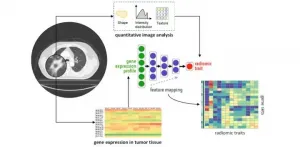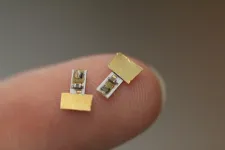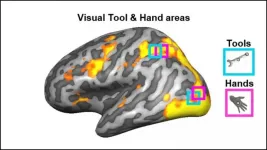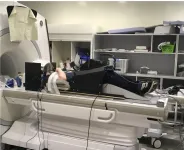(Press-News.org) Recurrent, metastatic breast cancer resists treatment and is usually fatal.
These tumors often have low numbers of immune cells in them, which renders immune therapies less effective for the disease.
This preclinical study suggests that drugs called CDK4 and CDK6 inhibitors may make immune-cell therapies an effective option for treating recurrent ER-positive metastatic breast cancer.
COLUMBUS, Ohio - A class of drugs that inhibits breast cancer progression when used with hormonal therapy might also boost the effectiveness of immune therapy in cases of recurrent, metastatic breast cancer, according to a new study led by researchers at The Ohio State University Comprehensive Cancer Center - Arthur G. James Cancer Hospital and Richard J. Solove Research Institute (OSUCCC - James).
Published in the journal Cell Reports, the findings of the animal study suggest that drugs called CDK4 and CDK6 (CDK4/6) inhibitors might improve the effectiveness of immune therapies for metastatic, estrogen-receptor-positive (ER+) breast cancer.
"We know that CDK4/6 inhibitors effectively slow the progression of newly diagnosed breast cancer, but they don't kill cancer cells," says principal investigator Anna Vilgelm, MD, a member of the OSUCCC - James Translational Therapeutics Program and assistant professor at the Ohio State College of Medicine. "Consequently, the disease often recurs, and then it is usually fatal because we have no effective therapies for recurrent disease.
"Our findings suggest that combining CDK4/6 inhibitors with immunotherapy might offer an effective treatment for recurrent, metastatic ER+ breast cancer," Vilgelm says.
Specifically, the study shows that CDK4/6 inhibitors can improve the efficacy of T-cell-based therapies such as adoptive T-cell transfer or T-cell-activating antibodies in animal models of breast cancer.
Immune therapies are proving to be effective treatments for a variety of cancers but not for advanced breast cancer. One problem is that breast tumors often have low numbers of cancer-killing T lymphocytes within the tumor. Such tumors tend to respond poorly to immune therapies.
"In addition, breast cancer patients with low numbers of tumor-infiltrating lymphocytes often have worse survival compared to patients with high numbers of infiltrating lymphocytes in their tumors," says Vilgelm.
The new study shows that CDK4/6 inhibitors cause breast tumors to secrete small proteins called chemokines that attract T cells. This can help to improve patients' response to cancer immunotherapies.
For this study, Vilgelm and her colleagues used the oral CDK inhibitor palbociclib, mouse models, breast cancer cell lines and analyses of The Cancer Genome Atlas (TCGA) to study the influence of CDK4/6 inhibitors and chemokine production in the tumor immune microenvironment and on patient outcomes.
Key findings include:
Pre-treatment with a CDK4/6 inhibitor improves recruitment of T cells into tumors and improved the outcome of adoptive cell therapy in animal models;
CDK4/6 inhibitor-treated human breast cancer cells produce T-cell-recruiting chemokines;
TCGA analysis showed that chemokine expression is a favorable prognostic factor in breast cancer patients;
mTOR-regulated metabolic activity is required for chemokine induction by CDK4/6 inhibition;
T-cell-recruiting chemokines may be useful prognostic markers for stratifying patients for immunotherapy treatment.
"Overall," Vilgelm says, "our findings suggest that CDK4/6 inhibitors may offer a therapeutic strategy that can attract T cells into breast cancer tumors, which mayincrease their sensitivity to immune therapies."
INFORMATION:
This study was supported by grants from the Breast Cancer Research Foundation, the National Institutes of Health (CA098131, CA233770-01, CA116021, CA116021-S1, CA68485, CA16672) and the Department of Veterans Affairs.
Other researchers involved in this study were Roman V. Uzhachenko, Vijaya Bharti, Zhufeng Ouyang, Chengli Shen, The Ohio State University; Ashlyn Blevins, Stacey Mont, Nabil Saleh, Hunter A. Lawrence, Sheau-Chiann Chen, Gregory D Ayers, Vanderbilt University; David G. DeNardo, Washington University, St. Louis; Carlos Arteaga, University of Texas Southwestern Medical Center; Ann Richmond, Department of Veterans Affairs, Tennessee Valley Healthcare System and Vanderbilt University.
About the OSUCCC - James
The Ohio State University Comprehensive Cancer Center - Arthur G. James Cancer Hospital and Richard J. Solove Research Institute strives to create a cancer-free world by integrating scientific research with excellence in education and patient-centered care, a strategy that leads to better methods of prevention, detection and treatment. Ohio State is one of only 51 National Cancer Institute (NCI)-designated Comprehensive Cancer Centers and one of only a few centers funded by the NCI to conduct both phase I and phase II clinical trials on novel anticancer drugs provided by the NCI. As the cancer program's 356-bed adult patient-care component, The James is one of the top cancer hospitals in the nation as ranked by U.S. News & World Report and has achieved Magnet® designation, the highest honor an organization can receive for quality patient care and professional nursing practice. With 21 floors and more than 1.1 million square feet, The James is a transformational facility that fosters collaboration and integration of cancer research and clinical cancer care.
A new survey led by researchers from North Carolina State University found that the future of hunting in the United States might look different than it has in the past.
In The Journal of Wildlife Management, researchers reported findings from a nationwide survey of college students' interest and participation in hunting. They found current, active hunters were more likely to be white, male and from rural areas, and to have family members who hunted. But they also found a group of potential hunters - with no hunting experience but an interest in trying it - who were more diverse in terms of gender, ...
Despite our remarkable advances in medicine and healthcare, the cure to cancer continues to elude us. On the bright side, we have made considerable progress in detecting several cancers in earlier stages, allowing doctors to provide treatments that increase long-term survival. The credit for this is due to "integrated diagnosis," an approach to patient care that combines molecular information and medical imaging data to diagnose the cancer type and, eventually, predict treatment outcomes.
There are, however, several intricacies involved. The correlation of molecular patterns, such as gene expression and mutation, with image features (e.g., how a tumor appears in a CT scan), is ...
HOUSTON - (May 10, 2021) - Implants that require a steady source of power but don't need wires are an idea whose time has come.
Now, for therapies that require multiple, coordinated stimulation implants, their timing has come as well.
Rice University engineers who developed implants for electrical stimulation in patients with spinal cord injuries have advanced their technique to power and program multisite biostimulators from a single transmitter.
A peer-reviewed paper about the advance by electrical and computer engineer Kaiyuan Yang and his colleagues at Rice's Brown School of Engineering won the best paper award at the IEEE's Custom Integrated Circuits Conference, held virtually in the last ...
According to the International Whaling Commission, whale-watching tourism generates more than $2.5 billion a year. After the COVID-19 pandemic, this relatively safe outdoor activity is expected to rebound. Two new studies funded by a collaborative initiative between the Smithsonian Tropical Research Institute (STRI) in Panama and Arizona State University (ASU) show how science can contribute to whale watching practices that ensure the conservation and safety of whales and dolphins.
"The Smithsonian's role is to provide scientific advice to policy makers as they pioneer management strategies to promote whale conservation," said STRI marine biologist, Hector Guzmán, whose previous work led the International Maritime Organization to establish shipping corridors ...
ATLANTA--Gestures--such as pointing or waving--go hand in hand with a child's first words, and twins lag behind single children in producing and using those gestures, two studies from Georgia State University psychology researchers show.
Twins produce fewer gestures and gesture to fewer objects than other children, said principal researcher Seyda Ozcaliskan, an associate professor in the Department of Psychology. Language use also lags for twins, and language--but not gesture--is also affected by sex, with girls performing better than boys, Ozcaliskan said.
"The implications are fascinating," said Ozcaliskan. ...
MISSOULA - University of Montana Professor Mark Hebblewhite has joined an international team of 92 scientists and conservationists to create the first-ever global atlas of ungulate (hoofed mammal) migrations.
Working in partnership with the Convention on the Conservation of Migratory Species of Wild Animals, a U.N. treaty, the Global Initiative on Ungulate Migration (GIUM) launches May 7 with the publication of a commentary in Science titled " END ...
Visual brain areas involved in processing hands also encode information about the correct way to hold tools, according to new research published in JNeurosci.
Each part of the brain's visual system activates in response to a certain type of item -- whether it's faces, tools, objects, or hands. Scientists assumed the brain segregates visual information in this way to optimize motor actions with tools. Yet most studies investigating the brain mechanisms for tool grasping used images of tools or hands, and no actual hand movements were performed.
Knights et al. used fMRI to measure the brain activity of participants as they grasped 3D-printed kitchen tools (spoon, knife, and pizza cutter) and similar-sized non-tools. ...
Researchers at the University of East Anglia have made an astonishing discovery about how our brains control our hands.
They used MRI data to study which parts of the brain are used when we handle tools, such as a knives.
They read out the signal from certain brain regions and tried to distinguish when participants handled tools appropriately for use.
Humans have used tools for millions of years, but this research is the first to show that actions such grasping a knife by its handle for cutting are represented by brain areas that also represent images of human hands, our primary 'tool' for interacting with the world.
The research ...
Imaging technology has come a long way since the beginning of photography in the mid-19th century. Now, many state-of-the-art cameras for demanding applications rely on mechanisms that are considerably different from those in consumer-oriented devices. One of these cameras employs what is known as "single-photon imaging," which can produce vastly superior results in dark conditions and fast dynamic scenes. But how does single-photon imaging differ from conventional imaging?
When taking a picture with a regular CMOS camera, like the ones on smartphones, ...
Peptides " short strings of amino acids" play a vital role in health and industry with a huge range of medical uses including in antibiotics, anti-inflammatory and anti-cancer drugs. They are also used in the cosmetics industry and for enhancing athletic performance. Altering the structure of natural peptides to produce improved compounds is therefore of great interest to scientists and industry. But how the machineries that produce these peptides work still isn't clearly understood.
Associate Professor Max Cryle from Monash University's Biomedicine Discovery Institute (BDI) has revealed a key aspect of peptide machinery in a paper published in Nature Communications today that provides a key to the "Holy Grail" of re-engineering peptides..
The findings will advance his lab's work into ...






